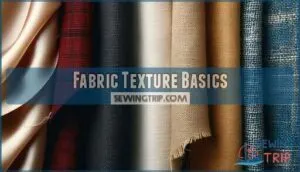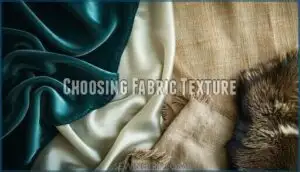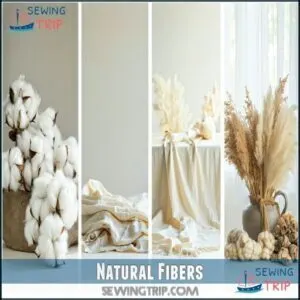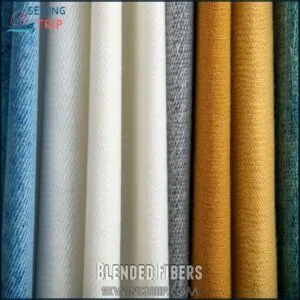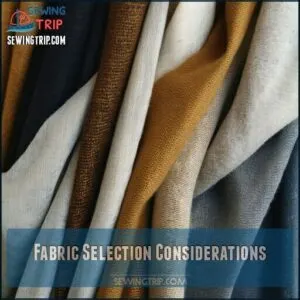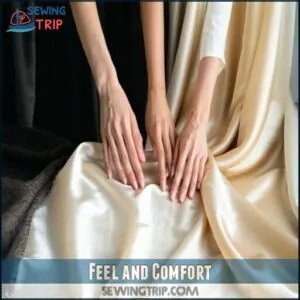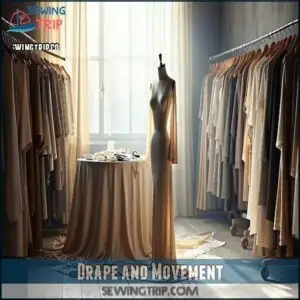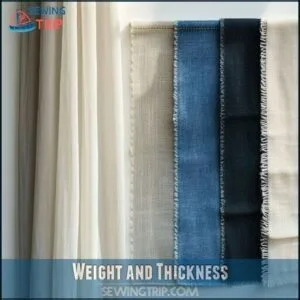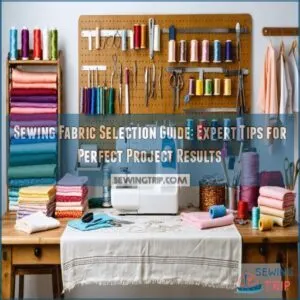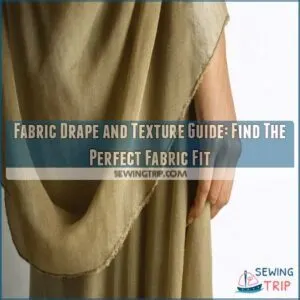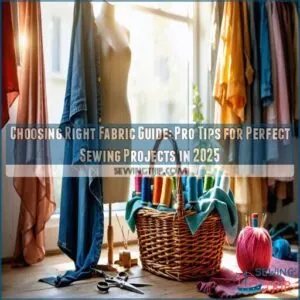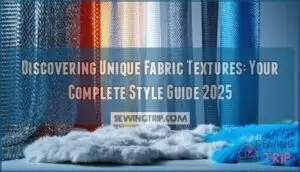This site is supported by our readers. We may earn a commission, at no cost to you, if you purchase through links.
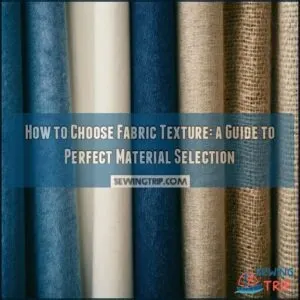
For a flowy dress, go for lightweight fabrics like chiffon or silk; for structure, opt for twill or denim.
Always feel the fabric—smooth textures like satin scream elegance, while rougher ones like burlap are rustic. Check drape and weight; heavier fabrics hold shape, while lighter ones move freely.
Don’t forget maintenance—some textures wrinkle easily or need special care. And if eco-friendliness matters, look for organic cotton or bamboo blends.
Think of fabric texture as the personality of your project—it sets the tone. Ready to explore the details? Let’s unravel more!
Table Of Contents
Key Takeaways
- Feel the fabric to assess its texture, drape, and weight—it affects how your project looks, moves, and feels.
- Match the fabric’s purpose to its durability, maintenance needs, and environmental factors like humidity.
- Consider sustainability by choosing eco-friendly options like organic cotton or recycled fibers.
- Understand fiber types, weave patterns, and finishes to pick textures that balance comfort, style, and functionality.
Fabric Texture Basics
When choosing fabric texture, it helps to understand the basics, like fiber types, weave patterns, and finishes.
These elements work together to create the look, feel, and durability of the material, making it essential to know what sets them apart.
Fiber Composition
Fiber composition shapes fabric texture.
Fiber composition defines fabric texture, blending comfort, durability, and innovation to create materials that suit every style and need.
Natural fibers like cotton or wool feel soft and breathable, while synthetic textures from polyester add durability.
Fiber blends offer the best of both worlds, combining comfort and strength. Microfibers create sleek textures, while novel fibers push innovation.
Understanding fiber analysis helps you choose textures that suit your project’s style and fabric texture characteristics.
To accurately determine a fabric’s composition, consider performing a fabric burn test.
Weaving Techniques
Weaving techniques are key to fabric texture and bring rich textile history to life.
Modern looms create endless possibilities through innovative weave patterns, blending fibers for durability and flair. Here’s how weaving shapes fabric:
- Plain weave: Simple and versatile.
- Twill: Durable with diagonal lines.
- Satin: Smooth and lustrous.
- Jacquard: Intricate designs.
- Digital weaving: Technology meets creativity.
Finishes and Treatments
Enhancing fabric’s texture often involves clever finishes like wrinkle resistance or stain protection.
Water repellency and fire retardancy add durability, while antimicrobial finishes prevent bacteria.
Modern treatments, like metallic or foiled finishes, create shine, and fabric lamination delivers iridescent effects.
These techniques balance aesthetic appeal with practicality, making fabrics both eye-catching and functional for your projects.
Choosing Fabric Texture
When choosing fabric texture, focus on how it feels, looks, and suits your project’s needs.
A well-chosen texture adds depth and functionality, whether you want cozy, sleek, or something in between.
Strategies For Effective Communication
When choosing fabric texture, communicating your vision matters. Active listening guarantees you understand preferences, while clear messaging defines the desired texture feel and appearance.
Use nonverbal cues, like showing swatches, for better discussions. Conflict resolution bridges disagreements on choices.
- Practice empathetic communication to balance opinions.
- Break down options in simple terms.
- Use visuals to compare textures.
- Ask questions to clarify needs.
Improving Team Collaboration Skills
How does team communication resemble fabric texture selection?
Shared goals, like pattern alignment, guarantee smooth collaboration.
Active listening is the thread connecting ideas, while role clarity weaves order into projects.
Conflict resolution, much like blending fibers, strengthens teamwork.
Considering fabric weight influences drape, which is similar to how team member contributions affect project outcomes.
By understanding fabric texture properties—feel, appearance, durability—you’ll master harmony, whether choosing materials or boosting team collaboration.
Overcoming Workplace Communication Barriers
Overcoming workplace communication barriers is a bit like choosing fabric texture—it’s all about balance and attention to detail.
For clarity and teamwork:
- Practice active listening to understand the fabric texture feel of your team’s concerns.
- Use inclusive language and nonverbal cues to improve the texture of conversations.
- Resolve conflicts tactfully, much like adjusting uneven fabric texture qualities.
Fabric Types and Textures
When choosing fabric, it’s important to understand how different types and textures affect appearance, comfort, and functionality.
From the smooth feel of satin to the cozy texture of wool, each fabric brings its own unique qualities to your project.
Natural Fibers
Natural fibers give fabrics their charm and functionality.
Cotton textures feel breathable and soft, perfect for everyday use. Linen fabric offers a crisp, airy feel, ideal for warmer weather.
Wool warmth wraps you in cozy comfort, while silk luxury adds a smooth, elegant touch.
Explore plant-based dyes for eco-friendly, vibrant hues that enhance every natural fiber’s unique appeal. Many seek specific cotton fabric patterns for various projects.
| Fiber | Texture | Best For | Special Feature |
|---|---|---|---|
| Cotton | Soft | Casual wear | Absorbs moisture easily |
| Linen | Crisp | Summer clothing | Lightweight and breathable |
| Wool | Cozy | Winter sweaters | Insulates naturally |
| Silk | Smooth | Formal outfits | Luxurious drape |
Synthetic Fibers
Synthetic fibers bring versatility to fabric texture.
Polyester properties make it durable and easy to care for, while acrylic textures feel light yet cozy.
Rayon applications add softness and flow, perfect for clothing.
Nylon durability shines in activewear, and microfiber benefits, like stain resistance, work for home essentials.
Spandex adds stretch, making synthetic material a functional, stylish option.
Many synthetics offer anti-wrinkling properties, increasing their appeal. Spandex adds stretch.
Blended Fibers
Blended fabrics combine the best of both worlds, using fiber combinations to maximize enhanced functionality.
Cotton blends offer softness and breathability, while material blends like polyester-knit improve durability and stretch.
Texture blending creates performance fabrics suited for versatile uses, from activewear to upholstery.
Understanding various blended options can greatly improve material choice. Fiber blending makes certain of blended durability, giving you balance between comfort, strength, and adaptable fabric texture for any project.
Specialty Fabrics
Feeling inspired by blended fibers? Specialty fabrics are where creativity meets function.
From laser-cut fabrics to foiled fabric’s metallic flair, these unique materials redefine elegance and utility.
Explore:
- Pre-pleated fabric: Permanent folds for dynamic styles.
- Shirred fabric: Adds whimsical textures.
- Technical knits: Comfort with innovation.
- Foiled fabric: Bold, shiny statements.
- Specialty textures examples: Perfect for unique fabric texture applications.
Explore options for purchasing pre-pleated fabrics to enhance your designs.
Fabric Selection Considerations
When choosing fabric, think about how it’ll be used, how durable it needs to be, and how easy it’s to maintain.
Balancing practicality, sustainability, and aesthetics helps you pick a texture that works perfectly for your project.
Purpose and Intended Use
Choosing fabric texture starts with its purpose.
Upholstery fabrics need durability for heavy use, while clothing fabrics require comfort and flexibility.
For home decor, prioritize style and longevity.
Consider environmental factors too, like humidity for mildew resistance.
Here’s a quick guide:
| Purpose | Recommended Textures | Key Characteristics |
|---|---|---|
| Upholstery Fabrics | Velvet, Microsuede | Durable, stylish |
| Clothing and Accessories | Cotton, Wool | Breathable, comfortable |
| Home Decor | Linen, Polyester Blend | Aesthetic, easy to clean |
Sustainability and Eco-Friendliness
Sustainability and eco-friendliness should influence your fabric choices.
Look for ecofriendly fabrics to reduce textile waste and support healthier production practices.
Consider:
- Organic certifications on organic cotton and natural fibers.
- Recycled fabrics, like those from reused plastics.
- Sustainable dyeing methods with less water and chemicals.
- Fabrics made in closed-loop systems.
- Recycled fibers for guilt-free style.
Explore options like durable hemp fabrics for greater sustainability.
Simple actions, big impact!
Durability and Maintenance
Fabric durability matters, especially in high-traffic spaces.
Look for wear resistance to handle everyday use, but don’t forget fabric care.
Always follow washing and drying instructions to keep texture retention intact.
Choose fibers with longevity and understand cleaning methods.
Stain removal tips can be a lifesaver, letting you enjoy a great look without compromising fabric maintenance.
Evaluating Fabric Texture
When evaluating fabric texture, focus on how it feels against your skin and how it moves when handled.
Fabric texture tells a story through touch and movement, blending comfort, style, and purpose into every project.
Consider factors like weight, thickness, and care requirements to guarantee it’s practical for your project. **
Feel and Comfort
Whether it’s a soft fabric texture like cashmere or the smooth fabric texture of satin, feel and comfort matter.
Skin sensitivity, tactile sensations, and the breathability factor shape your sensory experience.
Consider thermal properties too—materials like wool keep you warm, while cotton cools.
A thoughtful choice guarantees your clothing texture truly matches your needs, blending comfort with function seamlessly.
Drape and Movement
Fabric drape makes all the difference in how clothes move with you.
Soft drape enhances fluid, flowing shapes—think silk or viscose.
Stiffer materials like denim create sharp, structured silhouettes.
A fabric’s flow can emphasize body movement or add texture influence to an outfit.
Remember, fabric texture and visual texture impact movement and how garments showcase your personal style.
Weight and Thickness
Lightweight fabrics like chiffon or linen add flow to summer outfits, while heavyweight fabrics such as denim or wool provide structure and warmth.
Fabric weight and thickness influence garment structure, upholstery density, and texture impact.
Layering fabric textures can create depth, but consider seasonal weight for comfort.
Always match fabric thickness to your project’s purpose for the best results.
Care and Maintenance Requirements
Caring for fabrics keeps them looking fresh and lasting longer. Know your washing techniques—natural fibers often need gentle cycles, while synthetics handle machine washes better.
Use air drying methods to prevent shrinkage, and follow ironing guidelines for smooth finishes.
For fabric longevity, store fabrics in cool, dry places.
- Pre-test stain removal methods.
- Avoid direct sunlight exposure.
- Rotate stored fabrics periodically.
- Use breathable storage bags.
Frequently Asked Questions (FAQs)
How do textured fabrics affect garment fit?
Ever tried squeezing into textured fabrics like chunky knits or ribbed weaves?
They can cling, add bulk, or limit stretch, altering fit.
Choose wisely—some textures flatter curves, while others might feel restrictive or oversized.
What tools simplify cutting textured fabrics?
Use sharp fabric scissors or a rotary cutter with a self-healing mat for precision.
Pattern weights help stabilize textured fabrics, while pinking shears prevent fraying.
A clear ruler guarantees clean, accurate cuts every time.
Can textured fabrics be dyed easily?
Textured fabrics can be dyed, but their uneven surfaces may absorb color differently, creating unique effects.
Natural fibers like cotton or wool take dye well, while synthetic blends may require special dyes for consistent results.
How to prevent snags in textured fabrics?
Protect textured fabrics by trimming sharp nails, avoiding rough jewelry, and steering clear of snag-prone surfaces like Velcro.
Use a fabric shaver for maintenance.
Store items in breathable bags to prevent accidental pulls.
What are budget-friendly textured fabric options?
Go for faux suede, corduroy, or felt for affordable textured options.
They’re versatile, durable, and elevate projects without costing much.
These fabrics bring unique finishes, adding depth and character to clothing, upholstery, or decor accents.
Conclusion
Imagine picking the perfect seasoning for a dish—that’s how choosing fabric texture shapes your project.
By understanding fiber types, drape, weight, and care, you’ll match texture to your needs effortlessly.
Whether you’re crafting a cozy blanket or an elegant gown, the right texture transforms your vision into reality.
Don’t overlook eco-friendly options like organic cotton if sustainability matters.
Knowing how to choose fabric texture makes certain your project’s personality shines through, combining function, beauty, and practicality seamlessly.

